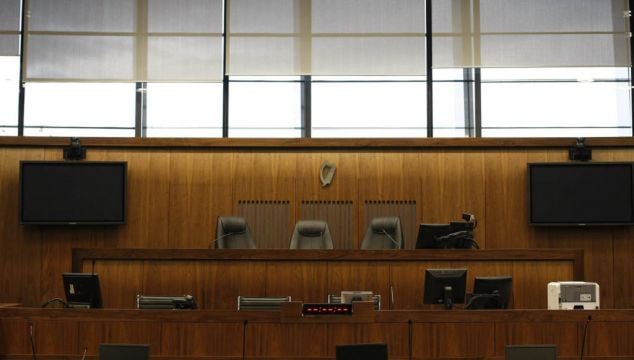Lifelong criminal Trevor Byrne, who dropped his phone at the scene of an armed robbery where he hijacked a woman’s car at gunpoint and threatened to kill her, has appealed his conviction, submitting that correct procedures were not followed when he was identified from CCTV.
Byrne, who has 44 previous convictions, was convicted in 2021 by the Special Criminal Court of five charges arising from the armed robbery of Boylesports in Applewood Village in Swords, Co Dublin, on March 19th, 2010.
Byrne (43), of Cappagh Road, Finglas West, Dublin, had pleaded not guilty to the robbery, possession of a firearm, false imprisonment, threatening to kill and to unlawfully seizing a vehicle used in the getaway.
The court had heard that Byrne was released from a separate sentence in November 2009, just four months before carrying out the Swords raid.
By the time of his sentencing in July 2021, the father of three was already serving a nine-year sentence for another firearms offence from November 2019.
At the Special Criminal Court in July 2021, Mr Justice Michael MacGrath sentenced Byrne to eight-and-a-half years for both the armed robbery and the false imprisonment, six-and-a-half years for the threat to kill and seven-and-half years each for the possession of the firearm and for hijacking the car.
Mr Justice MacGrath said that all five sentences arising from the raid on the bookies would run concurrently to each other but would run consecutively to the conviction for the other firearm offence of November 2019, resulting in jail sentences totalling 17.5 years.
Byrne has appealed all five convictions arising from the robbery of the bookies.
Appeal
At the Court of Appeal on Thursday, John D Fitzgerald SC, for Byrne, said the conviction of his client could have been “unsafe” due to the lack of contemporaneous notes taken by gardaí around the CCTV identification process.
Mr Fitzgerald said his client was appealing the convictions, submitting that the identification evidence of Detective Garda Patrick McDonagh from the CCTV footage recorded inside the bookies should not have been admissible in the trial.
Det Gda McDonagh was the only Garda in the case to give evidence of recognising Byrne from the CCTV.
The detective said he had worked in Finglas for 17 years and been on regular mobile patrols, during which he encountered the appellant and had previously arrested him.
Det Gda McDonagh had said he was “100 per cent certain” the man in the footage was Byrne.
Det Gda Mcdonagh said he had not been given any details of the purpose of the identification request, other than that there had been a robbery and that the getaway car had been abandoned in Finglas.
Mr Fitzgerald said that Det Gda McDonagh had said he could see the appellant’s “eyes, nose and mouth” from the footage. However, counsel said, the detective had then been shown a CCTV still, from which he made the identification, that did not show the appellant’s eyes.
'Pace'
Mr Fitzgerald said Det Gda McDonagh said he was familiar with the procedures of identification contained within the UK’s Police and Criminal Evidence Act 1984 – or ‘Pace’ – which is increasingly being adopted in Ireland.
Mr Fitzgerald said the failure to take notes of the identification process was at odds with the Pace codes, which were procedures to ensure “transparency and fairness, especially when the identification is historic and the [Garda] witness in charge of the procedure was unavailable to give evidence”.
Shane Costello SC, for the State, said there had been no unfairness in the procedure, that the Pace code did not apply to this jurisdiction and that the failure to record the process did not render the evidence inadmissible but merely meant a consideration was needed regarding what weight to give the evidence.
However, Mr Fitzgerald said the failure to document the identification “severely hampered the ability of the defence to effectively cross-examine and probe the identification aspect of the prosecution’s case”.
This “failure”, counsel said, amounted to a “fundamental unfairness” to the appellant.
“The procedural defects were such as to render the conviction of the appellant unsafe,” Mr Fitzgerald submitted.
'Perfectly positioned'
Mr Costelloe said the CCTV evidence was supplemental to other circumstantial evidence such as Byrne dropping a phone at the bookies.
The phone, counsel said, had a number that Byrne submitted in a passport application. Mr Costelloe said that when Byrne was arrested, he had two phones on him that both had a connection to the dropped phone.
“The footage was extraordinary - two men go into the bathroom of the bookies, and they hide in the ceiling before they drop out again 35 minutes later.
“The whole thing was captured from multiple angles. Det Gda McDonagh says the one raising the phone in the CCTV is Trevor Byrne.
“Det Gda McDonagh says he knows that because he says: ‘I know, I worked in the area for 17 years and arrested him in the past’,” Mr Costelloe said.
Counsel said Det Gda McDonagh was “perfectly positioned to say he recognised him [Byrne]”.
Mr Costelloe said the CCTV was of “good quality” and that the appellant had “pointed to no law” saying the evidence should be inadmissible.
Presiding Court of Appeal judge Mr Justice John Edwards said the court would reserve its judgment in the matter.







